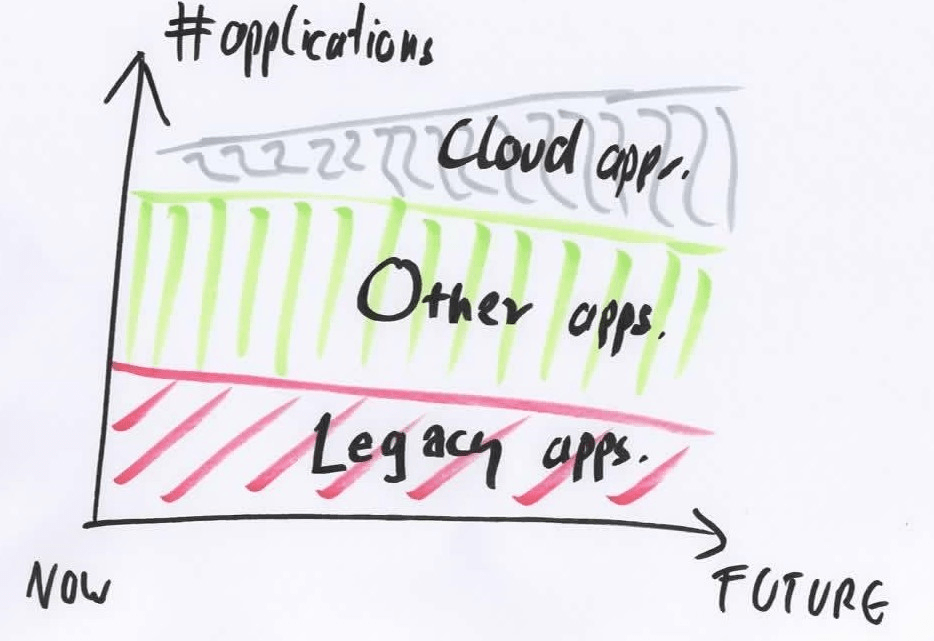Everyone is talking about the transformation that cloud computing will bring about. New possibilities, unlimited scaling, pay-as-you-go. The effects of the cloud transformation will soon be felt, and some may be unpleasant. (Application) portfolio managers need to be aware.
The cloud revolution is here. Nobody will deny it. Cloud events draw big crowds. All the major companies have set up their cloud competency centers and are working hard to deploy new applications in the cloud. So, sooner or later, application portfolio managers will report on a new category of applications – those running in the cloud. What will the impact be?
Let’s first take a look at those “pioneer” applications that will go to the cloud first. It’s safe to assume that these will be a) new applications and b) those that will benefit especially from the cloud (e.g. by profiting from high scalability, elasticity, global reach, and easy access to innovative services for AI, data analytics, security). In other words, these applications go to the cloud because they can not be implemented in another way, at least not economically. So, cloud-applications (let’s simply call them that) will come and there will be no alternative.
On the other end of the application portfolio, there is no change. There are applications that run on proprietary (and typically old) technology that is not available in the cloud. Applications running on HP NonStop and of course most mainframe applications fall into this legacy category. This category has been here for years, and often stubbornly resisted all attempts to force modernization. The advent of the cloud will not miraculously change things. Often, there is simply no way to justify legacy migration to business, as costs are prohibitive, project risks high, and business benefits few. (However, this is not the focus of this post today!)
Then, there is a third category which contains all the applications that are neither legacy nor cloud („other applications„). I’m of course simplifying here, but let’s just go with the idea for the moment. So, we’ve got a large number of applications running on various technologies. They all could – in theory – be migrated to the cloud, it’s (by definition) at least not technologically impossible. Whether it would be economically sound is a different question. Typically, there is little incentive to migrate individual applications to the cloud as long as they do not depend on particular cloud features like those in the “cloud applications” category.
Let’s take a look at a visualization of this portfolio and its future development:
I assume here that the number of cloud applications is growing, and the number of legacy applications is – just very slowly – going down. The big question, however, is what will happen to the rest.
In reality the group «others» is not homogeneous but itself comprised of clusters of common technology, architecture, or other common attributes. These clusters might be aligned with business in the sense that similar applications also serve a common business goal (such as supporting a particular process or product), but this might also not be the case.
Similar, the «Cloud» category can be further broken down into clusters, such as e.g. for Google-native, AWS-native, Azure-native applications – and there will (hopefully) be portable cloud applications, too.
In other words, cloud computing will mean – to the cynical application portfolio manager – a set of additional silos that demand specific skills and specific management efforts. “Additional” in bold print. That means additional costs. And this is the ugly reality: Cloud computing might very well lead to an increase of total IT spending. This is not what the ads say and what CIOs hope for.
What can be done? From the portfolio view the answer is straightforward. If there are new silos coming and nothing can be done about it, then one needs to get rid of other (old) silos. In other words: migration of applications (from the “other” category) to the cloud. As simple as that.
But, wait a moment, didn’t I just tell you 5 minutes ago that there wouldn’t be a good business case for this? Right – but this is the point. A cloud migration business case that makes no sense for individual applications could suddenly look much more positive if it is being calculated for a whole “cluster” of applications, for a whole silo. The logic behind this is clear: Once you can get rid of all applications in a cluster, you can really decommission platforms, technologies, cancel contracts with vendors and consultants, re-train teams. These benefits don’t show up in a single application migration case, but they will once you switch the perspective to the portfolio, to a whole group of similar applications.
In other words, one needs systematic cloud migration programs to get – step-by-step – rid of the most expensive on prem technologies and platforms.
This is not a simple path, of course. Migration programs are challenging. Migration programs tend to get stuck halfway through – barely a success in economic terms. But the alternative is to live with steadily rising IT costs, and rising complexity. It’s much better to start working on a systematic cure now than pushing activity further down the line.
In fact, this could mean exciting times for the application portfolio manager’s role. The portfolio perspective becomes more important and more valuable:
- Helping to devise an efficient and meaningful way of application clustering.
- Helping to identify target clusters for migration.
- Supporting business cases.
- Guiding migration with clear KPIs…Sounds better than just presenting the same portfolio report every month, doesn’t it?




